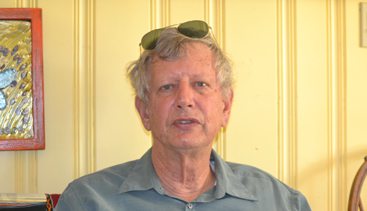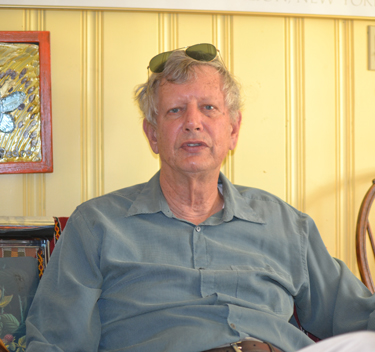

Ann Needle
By Ann Needle
Environmentalist Peter Alden recently spoke at the Assabet River National Wildlife Refuge Visitor Center on the “Ups and Downs of Our Birds and Mammals.” The Independent caught up with the renown author of several National Audubon and Peterson field guides at his home in Concord. Alden spoke about how and why the plants and wildlife in the area are distinctly different from recent centuries, and what this means for the local environment.
Fall foliage is now covering MetroWest’s abundant collection of trees. But, Peter Alden pointed out, there was a time in the 1800s when Massachusetts looked more like a scene from “Little House on the Prairie.”
With New England’s forests aggressively cleared for farm land in the 17th and 18th centuries, Alden explained that animals that relied on trees and brush for survival disappeared. As a result, storied naturist Henry David Thoreau—who made copious notes about nature at Walden Pond in the mid-1800s — “never saw a deer; he did not see beaver lodges.” Compounding the de-foresting going on at the time, Alden said, “You had a gun, you went out, you killed it. There was no Endangered Species Act. Everybody wanted to wear beaver coats.
“We became the ‘prairie states’ for a few years,” he continued. With New England at about 90% open land around 1850, this cleared land attracted species native to the Midwest, such as Meadowlarks.
Since then, the decrease in New England farms over the past century is partly responsible for the Meadowlark, among other non-natives, becoming endangered here. “All our money is being spent on protecting species that aren’t even native to here. Everybody thinks it’s all going to hell.”
Another reason Alden pointed to for native species returning is, “Thanks to wise citizens, we’ve banned DDT and other pesticides. So, Bald Eagles are nesting again, as are Ospreys.” He mentioned that the dramatic drop-off in hunting also has contributed to survival rates.
Alden is quick to point out he has nothing against Meadowlarks, or other non-natives. However, he expressed concern that residents have lost sight of the riches accompanying the return of New England’s forests. This means moose and Black Bears are back, along with the Wild Turkey. “Wild Turkeys hang around in gangs, and they have sharp claws and beaks. No coyote wants to lose his eye sight,” he said.
And, as Alden explained it, one return can lead to another. As the woods re-appeared, beavers once again found trees for building lodges. In turn, this has brought back the Blue Heron, which find ideal nesting grounds in the ponds and defoliated trees beavers create.
“Thoreau would be amazed at the return of many of these creatures,” Alden said. “And he would be pleasantly surprised with how climate change scientists have been working with the data he gathered.”
But, Alden cautioned that one man-made phenomenon continues to trigger changes in local plant and bird species – but that culprit is not climate change.
What’s Wrong with Climate Change
Some bird species native to the South—such as the Tufted Titmouse and Red-bellied Woodpecker — now are seen regularly in the area. However, Alden insisted, “It does NOT prove climate change! It’s bad science to believe that.”
Instead, he pointed to local gardeners’ “desires to have the latest trees, shrubs, shoots, for their gardens.” Many popular non-native plants, including Oriental Bittersweet and Porcelain-berry, have fruits attractive to some non-native birds. From there, the birds spread the seeds through their excrement. And though often colorful, these non-native plants have become extremely invasive, causing the extinction of some local wildflowers.
Meanwhile, the explosion in the number of birds feeders in the area — especially those used in the winter — could be changing some migratory patterns. For instance, full bird feeders appear to be keeping the Mourning Dove from migrating in the cold months, Alden said, “And I’m not sure if that’s good or bad.”
The bad part is that birds crowd onto these full feeders in the winter, making the feeders what Alden termed “cesspools of bacteria. They’re also subsidizing the injured and sick birds, which is not healthy.” On the other hand, Alden noted that full feeders in the summer are not nearly as hazardous, given birds have plenty of other food sources, keeping them from crowding one another.
However, Alden stressed that climate change is no innocent bystander in the earth’s environmental issues.
“Climate change is a real threat,” he maintained. Having worked as an international travel guide, “I’ve been to Antarctica a few dozen times. After 30 years, I’ve seen the sea ice shrink.” Scheduled to go back there this week and stay until December, Alden noted that the lack of sea ice has likely contributed to situations such as the rapidly shrinking polar bear population.
To those who think Earth’s populations could easily adapt to climate change, Alden said, “All these idiots think, we’ll just farm the Arctic. Well, you can’t farm rocks.”
While well traveled, Alden continues to work in cataloging local wildlife. He is the founder and current co-compiler of the Concord Christmas Bird Count, which sees volunteers in Concord and surrounding communities — Stow included — spending a day in December identifying as many bird species as possible.
The way Alden told it, Stow holds its own quite well against the Count’s founding town. “Here in Concord, we’re very pleased with what we’ve found. But it was very irritating one year; some relatively small teams from Stow beat us out.”